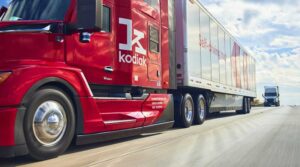Throughout history, humans have adapted to new technology as it became available. In most cases, innovations involved refinements to familiar products — but every so often a watershed moment occurred that changed everything.
In the early days of freight transportation, cargo was transported by horse (or ox) and wagon. Then, along came the internal combustion engine, paving the way for the first trucks. This changed freight hauling forever. Through the generations that followed, trucks continued to evolve, becoming larger and more powerful, and operating them became easier and more comfortable.
Trucking is on the cusp of another watershed moment.
From the time draft animals pulled the first freight wagon to modern-day tractor-trailers, navigation has been controlled by a human. This is changing. The day is coming when trucks will drive themselves. There are, however, steps that must be taken before autonomous trucks become commonplace in the industry. Defining those steps and how long it will take to implement them is still being discussed.
“People ask all the time, ‘When is this going to happen?’” said Dan Goff, director of external affairs for Kodiak Robotics. “The answer is that it’s already happening. You can get off a plane in Phoenix today and take a driverless taxi to your hotel. There are driverless taxis right now, driving around in San Francisco. They’re being tested in Los Angeles and in cities across Texas and in Miami.”
Goff is speaking about passenger vehicles, of course, but the technology that makes them work is identical to what’s being used for large trucks, with one notable exception: maps.
“The way a lot of those taxis work is, they have a very detailed map of everything happening around the vehicle,” he explained. “Every curve, every street sign, every mailbox is in the database. They might be able to discern, for example, a person standing between the vehicle and a mailbox and respond, but the basic route, down to the inch, is programmed in.”
Trucks, however, don’t spend a lot of time on carefully laid-out city streets. Instead, they might be on limited access highways where mailboxes and light poles usually aren’t an issue — but rapidly changing surface, weather, and traffic conditions are. Autonomous systems for heavy-duty vehicles must be able to identify changing conditions and respond appropriately, just as a human driver would.
Advanced driver assistance systems (ADAS), such as collision mitigation and adaptive cruise control, are pieces of autonomous technology that are already in use, enhancing the safety of rather than replacing drivers.
Developers of these technologies have come and gone. Waymo, the autonomous driving segment of Google parent Alphabet, recently announced it is slowing its pursuit of its commercial trucking to put more effort into its autonomous taxi operation. After months of plummeting stock prices and threats of being delisted, TuSimple, announced in June that it is shifting development efforts on the Asian market and exploring the sale of its U.S. operation. The company declined to discuss its U.S. operations for this story.
Even as the technology is refined, a host of regulatory hurdles remain. Laws for autonomous vehicles vary in different jurisdictions, and some people are warning that oversight of the developing technology isn’t adequate.
On July 26, the Innovation, Data, and Commerce Subcommittee of the U.S. House Energy and Commerce Committee held a hearing on the issue, entitled “Self-Driving Vehicle Legislative Framework: Enhancing Safety, Improving Lives and Mobility, and Beating China.”
The group called on the U.S. Department of Transportation to develop rules and a safety priority plan for autonomous vehicles, issue new vehicle safety standards, and develop testing methods. Included was a requirement for manufacturers to develop a cybersecurity plan to combat hacking efforts.
Dr. Philip Koopman, associate professor of electrical and computer engineering at Carnegie Mellon University, testified, “There is no independently vetted data showing automated driving features improve safety.” He also noted, “There is nothing inherent to this technology that guarantees that safety will be improved.”
Koopman also addressed the discrepancy in state and local laws.
“Companies can shop for a state that has favorable laws and operational conditions as they like,” he said.
Most of the prototype testing of autonomous trucks has indeed occurred in the southern tier of states where climate conditions are favorable and regulatory oversight, perhaps, more lenient.
Beyond regulations, there will be opposition from unions and politicians that are bent on protecting jobs. The Teamsters, in particular, have pushed for laws that require a driver in every truck, regardless of automation.
In the meantime, autonomous vehicle developers, in partnership with carriers, shippers, and truck manufactures, are hauling freight every day. Kodiak — in partnership with C.R. England, Werner, Forward Air, CEVA Logistics, and 10 Roads Express — is operating autonomous trucks to deliver freight for IKEA, Tyson Foods, the U.S. Department of Defense, and more. In June, Loadsmith announced its intent to equip 800 trucks with Kodiak technology in the first transportation company built for self-driving trucks.
Goff credits the Kodiak “SensorPod” with the company’s success to date. Rather than attaching brackets and bars to the tractor, Kodiak’s cameras and sensor are built into units that replace the mirrors.
“We know from our work with our partners that maintenance and keeping trucks on the road is one of the most important and difficult jobs for fleets,” he explained. “And we have really built our hardware technology to be easy to build, easy to maintain. If something happens on the road, (if) the sensor stack needs maintenance, we can actually send a technician to YouTube, and they can change a SensorPod out in about 10 minutes.”
Goff envisions autonomous trucks being used for the long-haul portion of freight loads, with local or regional drivers handling pickup and delivery. Kodiak has developed a network of transport hubs where trailers are exchanged with drivers.
“The value of adding this technology to a truck is that you’re going to be able to increase the utilization of that asset pretty dramatically,” he said.
Autonomous trucks could be a way to help relieve the shortage of drivers while improving the safety record of the trucking industry and helping carriers get more return on their equipment investment. Like the replacement of wagons pulled by draft animals by gas-powered vehicles, it will be a process that takes years (perhaps decades) as the industry finds new ways to streamline the driver’s job.
This article originally appeared in the September/October 2023 edition of Truckload Authority, the official publication of the Truckload Carriers Association.
Cliff Abbott is an experienced commercial vehicle driver and owner-operator who still holds a CDL in his home state of Alabama. In nearly 40 years in trucking, he’s been an instructor and trainer and has managed safety and recruiting operations for several carriers. Having never lost his love of the road, Cliff has written a book and hundreds of songs and has been writing for The Trucker for more than a decade.















